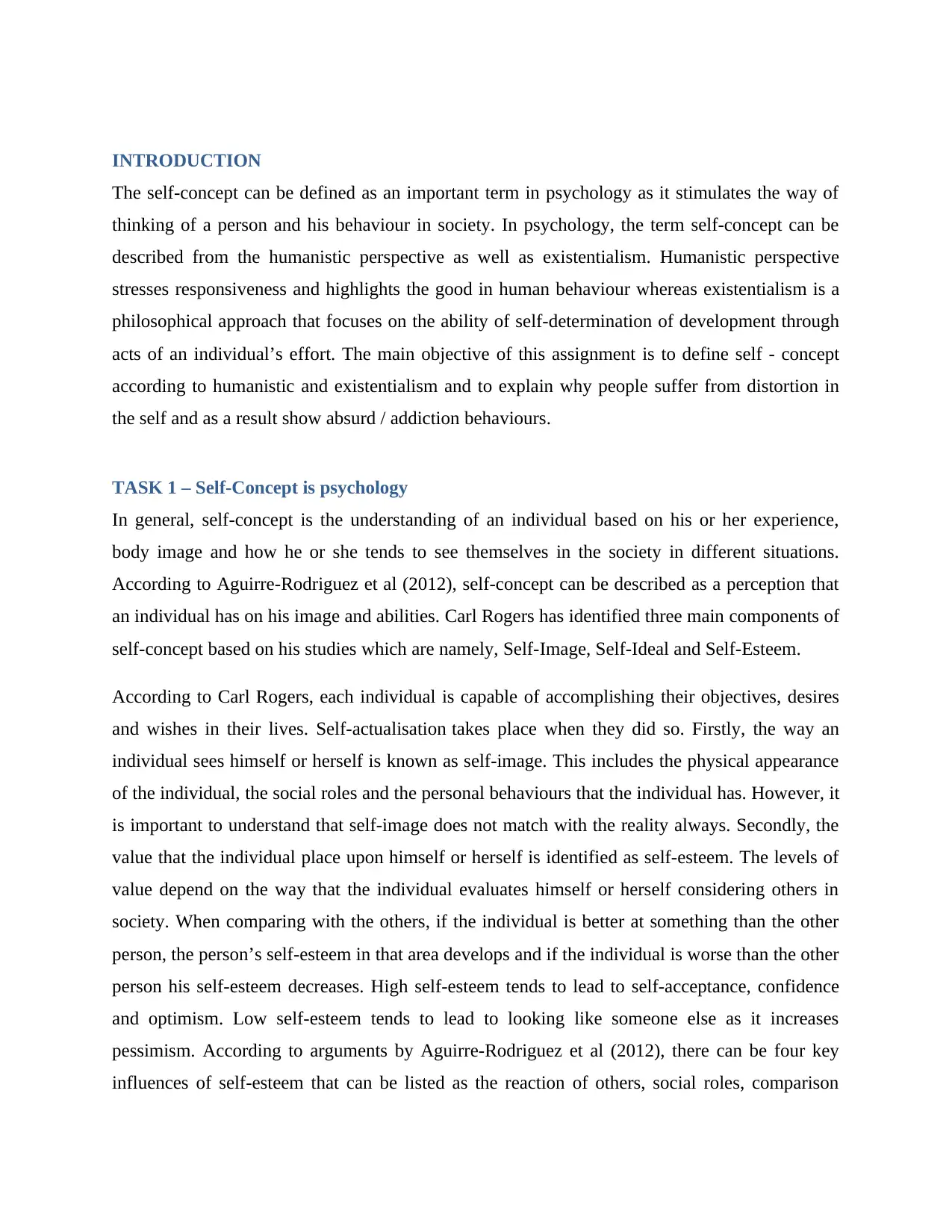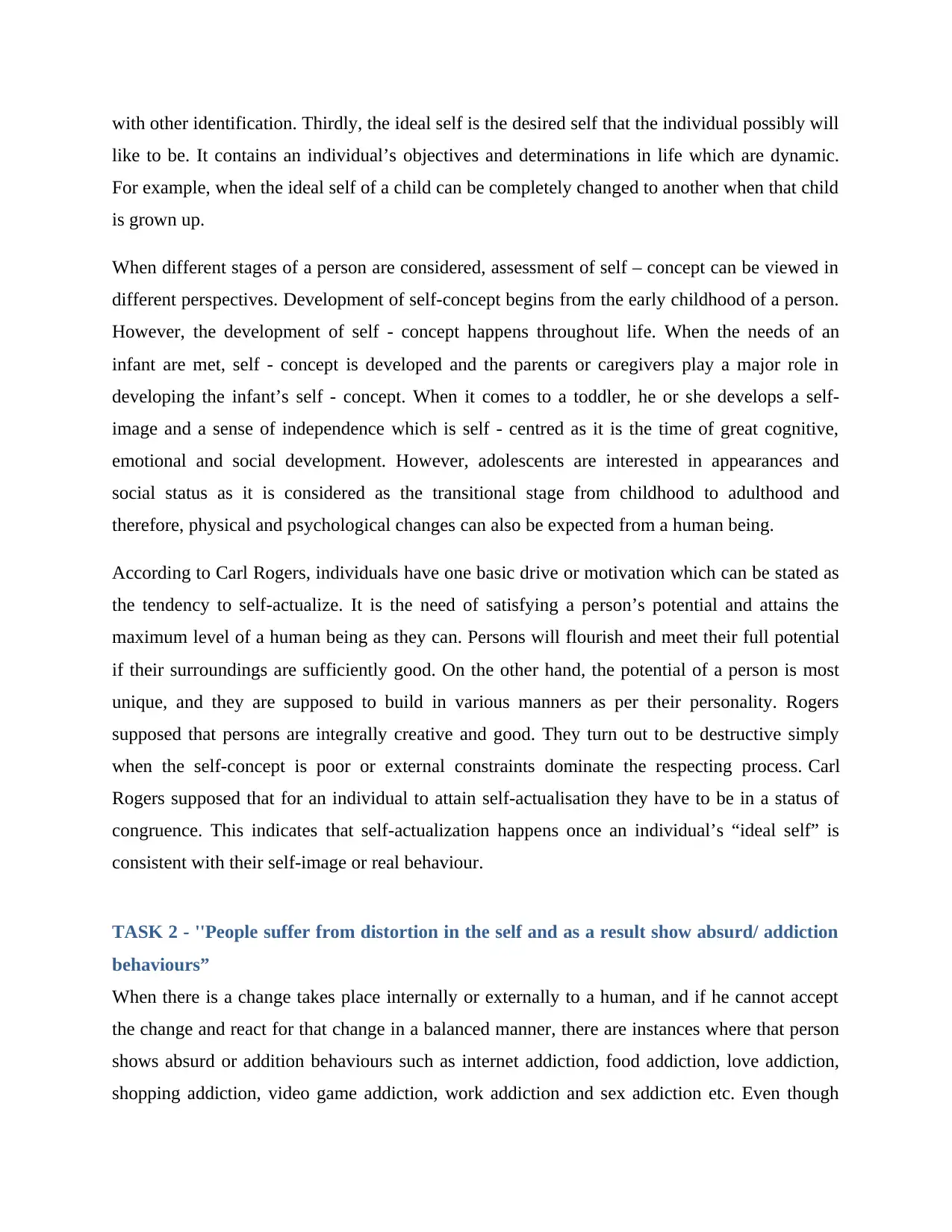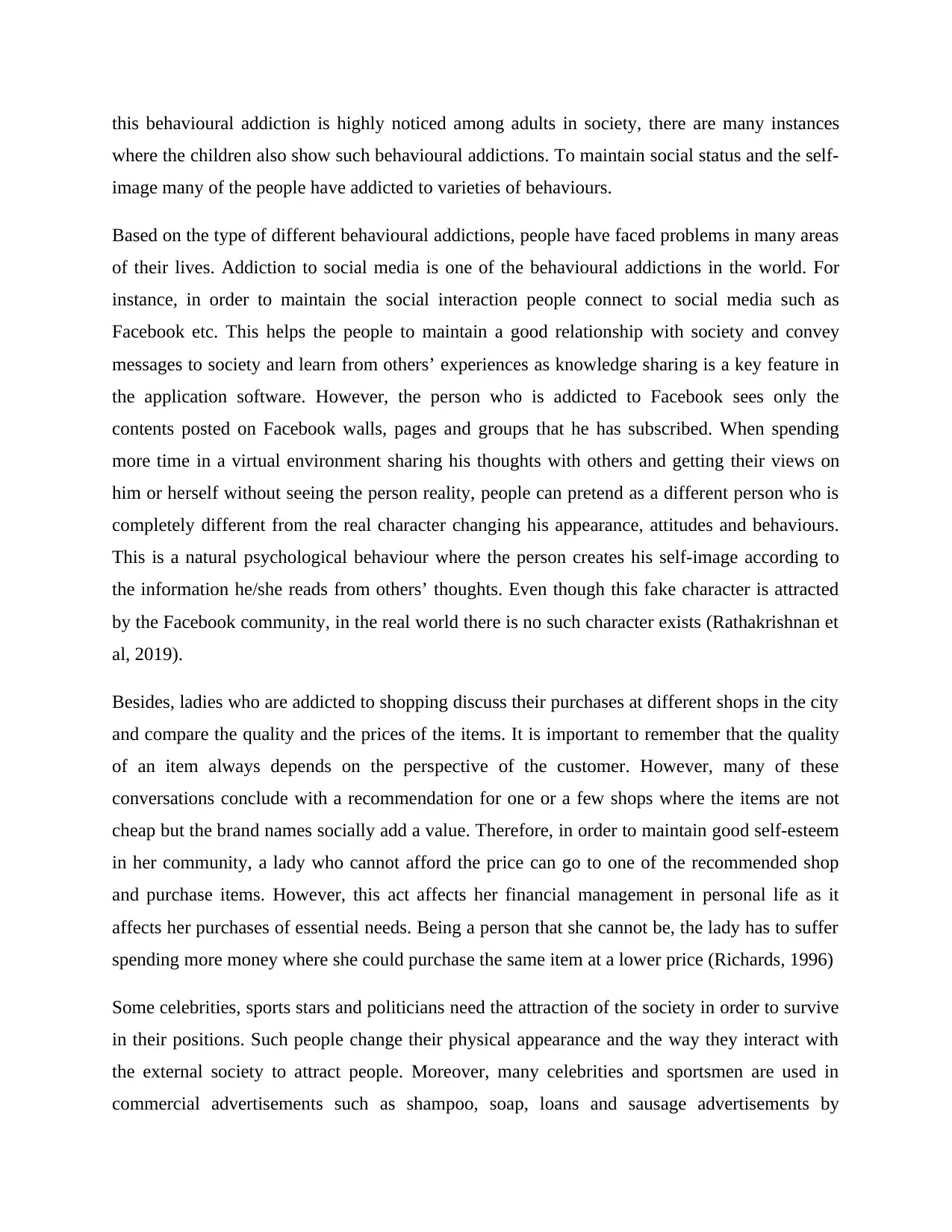Self-Concept, Distortion, and Addiction: A Psychology Essay Analysis
VerifiedAdded on 2021/10/14
|7
|1844
|207
Essay
AI Summary
This essay delves into the psychological concept of self-concept, defining it from both humanistic and existential perspectives. It explores the components of self-concept, including self-image, self-esteem, and the ideal self, as outlined by Carl Rogers. The assignment examines how the development of self-concept begins in early childhood and continues throughout life, influenced by interactions with others and societal pressures. Furthermore, it analyzes how distortions in self-concept can lead to various forms of addiction, such as social media, shopping, and other behavioral patterns, highlighting the impact of these distortions on an individual's well-being and social interactions. The essay concludes by emphasizing the importance of understanding and maintaining a congruent self-concept to avoid the negative consequences of distorted self-perceptions.

SELF-CONCEPT
<Name>
<Name>
Paraphrase This Document
Need a fresh take? Get an instant paraphrase of this document with our AI Paraphraser

Contents
INTRODUCTION.......................................................................................................................................2
TASK 1 – Self-Concept is psychology........................................................................................................2
TASK 2 - ''People suffer from distortion in the self and as a result show absurd/ addiction behaviours”....3
CONCLUSION...........................................................................................................................................5
REFERENCES............................................................................................................................................5
INTRODUCTION.......................................................................................................................................2
TASK 1 – Self-Concept is psychology........................................................................................................2
TASK 2 - ''People suffer from distortion in the self and as a result show absurd/ addiction behaviours”....3
CONCLUSION...........................................................................................................................................5
REFERENCES............................................................................................................................................5

INTRODUCTION
The self-concept can be defined as an important term in psychology as it stimulates the way of
thinking of a person and his behaviour in society. In psychology, the term self-concept can be
described from the humanistic perspective as well as existentialism. Humanistic perspective
stresses responsiveness and highlights the good in human behaviour whereas existentialism is a
philosophical approach that focuses on the ability of self-determination of development through
acts of an individual’s effort. The main objective of this assignment is to define self - concept
according to humanistic and existentialism and to explain why people suffer from distortion in
the self and as a result show absurd / addiction behaviours.
TASK 1 – Self-Concept is psychology
In general, self-concept is the understanding of an individual based on his or her experience,
body image and how he or she tends to see themselves in the society in different situations.
According to Aguirre-Rodriguez et al (2012), self-concept can be described as a perception that
an individual has on his image and abilities. Carl Rogers has identified three main components of
self-concept based on his studies which are namely, Self-Image, Self-Ideal and Self-Esteem.
According to Carl Rogers, each individual is capable of accomplishing their objectives, desires
and wishes in their lives. Self-actualisation takes place when they did so. Firstly, the way an
individual sees himself or herself is known as self-image. This includes the physical appearance
of the individual, the social roles and the personal behaviours that the individual has. However, it
is important to understand that self-image does not match with the reality always. Secondly, the
value that the individual place upon himself or herself is identified as self-esteem. The levels of
value depend on the way that the individual evaluates himself or herself considering others in
society. When comparing with the others, if the individual is better at something than the other
person, the person’s self-esteem in that area develops and if the individual is worse than the other
person his self-esteem decreases. High self-esteem tends to lead to self-acceptance, confidence
and optimism. Low self-esteem tends to lead to looking like someone else as it increases
pessimism. According to arguments by Aguirre-Rodriguez et al (2012), there can be four key
influences of self-esteem that can be listed as the reaction of others, social roles, comparison
The self-concept can be defined as an important term in psychology as it stimulates the way of
thinking of a person and his behaviour in society. In psychology, the term self-concept can be
described from the humanistic perspective as well as existentialism. Humanistic perspective
stresses responsiveness and highlights the good in human behaviour whereas existentialism is a
philosophical approach that focuses on the ability of self-determination of development through
acts of an individual’s effort. The main objective of this assignment is to define self - concept
according to humanistic and existentialism and to explain why people suffer from distortion in
the self and as a result show absurd / addiction behaviours.
TASK 1 – Self-Concept is psychology
In general, self-concept is the understanding of an individual based on his or her experience,
body image and how he or she tends to see themselves in the society in different situations.
According to Aguirre-Rodriguez et al (2012), self-concept can be described as a perception that
an individual has on his image and abilities. Carl Rogers has identified three main components of
self-concept based on his studies which are namely, Self-Image, Self-Ideal and Self-Esteem.
According to Carl Rogers, each individual is capable of accomplishing their objectives, desires
and wishes in their lives. Self-actualisation takes place when they did so. Firstly, the way an
individual sees himself or herself is known as self-image. This includes the physical appearance
of the individual, the social roles and the personal behaviours that the individual has. However, it
is important to understand that self-image does not match with the reality always. Secondly, the
value that the individual place upon himself or herself is identified as self-esteem. The levels of
value depend on the way that the individual evaluates himself or herself considering others in
society. When comparing with the others, if the individual is better at something than the other
person, the person’s self-esteem in that area develops and if the individual is worse than the other
person his self-esteem decreases. High self-esteem tends to lead to self-acceptance, confidence
and optimism. Low self-esteem tends to lead to looking like someone else as it increases
pessimism. According to arguments by Aguirre-Rodriguez et al (2012), there can be four key
influences of self-esteem that can be listed as the reaction of others, social roles, comparison
⊘ This is a preview!⊘
Do you want full access?
Subscribe today to unlock all pages.

Trusted by 1+ million students worldwide

with other identification. Thirdly, the ideal self is the desired self that the individual possibly will
like to be. It contains an individual’s objectives and determinations in life which are dynamic.
For example, when the ideal self of a child can be completely changed to another when that child
is grown up.
When different stages of a person are considered, assessment of self – concept can be viewed in
different perspectives. Development of self-concept begins from the early childhood of a person.
However, the development of self - concept happens throughout life. When the needs of an
infant are met, self - concept is developed and the parents or caregivers play a major role in
developing the infant’s self - concept. When it comes to a toddler, he or she develops a self-
image and a sense of independence which is self - centred as it is the time of great cognitive,
emotional and social development. However, adolescents are interested in appearances and
social status as it is considered as the transitional stage from childhood to adulthood and
therefore, physical and psychological changes can also be expected from a human being.
According to Carl Rogers, individuals have one basic drive or motivation which can be stated as
the tendency to self-actualize. It is the need of satisfying a person’s potential and attains the
maximum level of a human being as they can. Persons will flourish and meet their full potential
if their surroundings are sufficiently good. On the other hand, the potential of a person is most
unique, and they are supposed to build in various manners as per their personality. Rogers
supposed that persons are integrally creative and good. They turn out to be destructive simply
when the self-concept is poor or external constraints dominate the respecting process. Carl
Rogers supposed that for an individual to attain self-actualisation they have to be in a status of
congruence. This indicates that self-actualization happens once an individual’s “ideal self” is
consistent with their self-image or real behaviour.
TASK 2 - ''People suffer from distortion in the self and as a result show absurd/ addiction
behaviours”
When there is a change takes place internally or externally to a human, and if he cannot accept
the change and react for that change in a balanced manner, there are instances where that person
shows absurd or addition behaviours such as internet addiction, food addiction, love addiction,
shopping addiction, video game addiction, work addiction and sex addiction etc. Even though
like to be. It contains an individual’s objectives and determinations in life which are dynamic.
For example, when the ideal self of a child can be completely changed to another when that child
is grown up.
When different stages of a person are considered, assessment of self – concept can be viewed in
different perspectives. Development of self-concept begins from the early childhood of a person.
However, the development of self - concept happens throughout life. When the needs of an
infant are met, self - concept is developed and the parents or caregivers play a major role in
developing the infant’s self - concept. When it comes to a toddler, he or she develops a self-
image and a sense of independence which is self - centred as it is the time of great cognitive,
emotional and social development. However, adolescents are interested in appearances and
social status as it is considered as the transitional stage from childhood to adulthood and
therefore, physical and psychological changes can also be expected from a human being.
According to Carl Rogers, individuals have one basic drive or motivation which can be stated as
the tendency to self-actualize. It is the need of satisfying a person’s potential and attains the
maximum level of a human being as they can. Persons will flourish and meet their full potential
if their surroundings are sufficiently good. On the other hand, the potential of a person is most
unique, and they are supposed to build in various manners as per their personality. Rogers
supposed that persons are integrally creative and good. They turn out to be destructive simply
when the self-concept is poor or external constraints dominate the respecting process. Carl
Rogers supposed that for an individual to attain self-actualisation they have to be in a status of
congruence. This indicates that self-actualization happens once an individual’s “ideal self” is
consistent with their self-image or real behaviour.
TASK 2 - ''People suffer from distortion in the self and as a result show absurd/ addiction
behaviours”
When there is a change takes place internally or externally to a human, and if he cannot accept
the change and react for that change in a balanced manner, there are instances where that person
shows absurd or addition behaviours such as internet addiction, food addiction, love addiction,
shopping addiction, video game addiction, work addiction and sex addiction etc. Even though
Paraphrase This Document
Need a fresh take? Get an instant paraphrase of this document with our AI Paraphraser

this behavioural addiction is highly noticed among adults in society, there are many instances
where the children also show such behavioural addictions. To maintain social status and the self-
image many of the people have addicted to varieties of behaviours.
Based on the type of different behavioural addictions, people have faced problems in many areas
of their lives. Addiction to social media is one of the behavioural addictions in the world. For
instance, in order to maintain the social interaction people connect to social media such as
Facebook etc. This helps the people to maintain a good relationship with society and convey
messages to society and learn from others’ experiences as knowledge sharing is a key feature in
the application software. However, the person who is addicted to Facebook sees only the
contents posted on Facebook walls, pages and groups that he has subscribed. When spending
more time in a virtual environment sharing his thoughts with others and getting their views on
him or herself without seeing the person reality, people can pretend as a different person who is
completely different from the real character changing his appearance, attitudes and behaviours.
This is a natural psychological behaviour where the person creates his self-image according to
the information he/she reads from others’ thoughts. Even though this fake character is attracted
by the Facebook community, in the real world there is no such character exists (Rathakrishnan et
al, 2019).
Besides, ladies who are addicted to shopping discuss their purchases at different shops in the city
and compare the quality and the prices of the items. It is important to remember that the quality
of an item always depends on the perspective of the customer. However, many of these
conversations conclude with a recommendation for one or a few shops where the items are not
cheap but the brand names socially add a value. Therefore, in order to maintain good self-esteem
in her community, a lady who cannot afford the price can go to one of the recommended shop
and purchase items. However, this act affects her financial management in personal life as it
affects her purchases of essential needs. Being a person that she cannot be, the lady has to suffer
spending more money where she could purchase the same item at a lower price (Richards, 1996)
Some celebrities, sports stars and politicians need the attraction of the society in order to survive
in their positions. Such people change their physical appearance and the way they interact with
the external society to attract people. Moreover, many celebrities and sportsmen are used in
commercial advertisements such as shampoo, soap, loans and sausage advertisements by
where the children also show such behavioural addictions. To maintain social status and the self-
image many of the people have addicted to varieties of behaviours.
Based on the type of different behavioural addictions, people have faced problems in many areas
of their lives. Addiction to social media is one of the behavioural addictions in the world. For
instance, in order to maintain the social interaction people connect to social media such as
Facebook etc. This helps the people to maintain a good relationship with society and convey
messages to society and learn from others’ experiences as knowledge sharing is a key feature in
the application software. However, the person who is addicted to Facebook sees only the
contents posted on Facebook walls, pages and groups that he has subscribed. When spending
more time in a virtual environment sharing his thoughts with others and getting their views on
him or herself without seeing the person reality, people can pretend as a different person who is
completely different from the real character changing his appearance, attitudes and behaviours.
This is a natural psychological behaviour where the person creates his self-image according to
the information he/she reads from others’ thoughts. Even though this fake character is attracted
by the Facebook community, in the real world there is no such character exists (Rathakrishnan et
al, 2019).
Besides, ladies who are addicted to shopping discuss their purchases at different shops in the city
and compare the quality and the prices of the items. It is important to remember that the quality
of an item always depends on the perspective of the customer. However, many of these
conversations conclude with a recommendation for one or a few shops where the items are not
cheap but the brand names socially add a value. Therefore, in order to maintain good self-esteem
in her community, a lady who cannot afford the price can go to one of the recommended shop
and purchase items. However, this act affects her financial management in personal life as it
affects her purchases of essential needs. Being a person that she cannot be, the lady has to suffer
spending more money where she could purchase the same item at a lower price (Richards, 1996)
Some celebrities, sports stars and politicians need the attraction of the society in order to survive
in their positions. Such people change their physical appearance and the way they interact with
the external society to attract people. Moreover, many celebrities and sportsmen are used in
commercial advertisements such as shampoo, soap, loans and sausage advertisements by

different companies (Fleck, 2012). In order to be such a popular star character, people may use
those products which may create health issues.
It is important to understand that, when a person has to act like a different person hiding his or
her real personality for a long time, it may affect to the person’s health issues, social issues and
failures to meet personal, professional and social responsibilities. As a result, he or she has to
suffer from distortion in the self. When a person lives and acts as the way that he is he will be
able to live happily.
CONCLUSION
Self-concept is the understanding of the person who is lived inside the person. Self-concept is a
combination of self-image, self-esteem and self-ideal. To become a successful person, it is
important to understand the self-concept accurately. Development of Self-concept starts from an
infant and develops throughout the life of a human. It is important to be the real inner person
without suffering from distortion as behavioural addictions are highly affected by Self-concept.
Where an individual’s ideal self and real experience is very similar or consistent, a congruence
state occurs. Not often, if ever does a total congruence state occur; all persons familiar a
particular incongruence amount. The congruence development is reliant on unconditional
positive esteem. Roger’s supposed that for an individual to attain self-actualisation they have to
be in a level of congruence
REFERENCES
1. Aguirre-Rodriguez, A., Bosnjak, M. and Sirgy, M.J., 2012. Moderators of the self-
congruity effect on consumer decision-making: A meta-analysis. Journal of Business
Research, 65(8), pp.1179-1188.
2. Fleck, N., Korchia, M. and Le Roy, I., 2012. Celebrities in advertising: looking for
congruence or likability?. Psychology & Marketing, 29(9), pp.651-662.
3. Rathakrishnan, B., Wani, M.A., Yahaya, S.A.B.A., Singh, S., Manish, B.S.M.R.K. and
Verma, K., 2019. Factors of Social Networking Towards the Development of Self-
Esteem, Social Skills and Learning Behavior Among Adolescents. people, 15(41), pp.32-
70.
those products which may create health issues.
It is important to understand that, when a person has to act like a different person hiding his or
her real personality for a long time, it may affect to the person’s health issues, social issues and
failures to meet personal, professional and social responsibilities. As a result, he or she has to
suffer from distortion in the self. When a person lives and acts as the way that he is he will be
able to live happily.
CONCLUSION
Self-concept is the understanding of the person who is lived inside the person. Self-concept is a
combination of self-image, self-esteem and self-ideal. To become a successful person, it is
important to understand the self-concept accurately. Development of Self-concept starts from an
infant and develops throughout the life of a human. It is important to be the real inner person
without suffering from distortion as behavioural addictions are highly affected by Self-concept.
Where an individual’s ideal self and real experience is very similar or consistent, a congruence
state occurs. Not often, if ever does a total congruence state occur; all persons familiar a
particular incongruence amount. The congruence development is reliant on unconditional
positive esteem. Roger’s supposed that for an individual to attain self-actualisation they have to
be in a level of congruence
REFERENCES
1. Aguirre-Rodriguez, A., Bosnjak, M. and Sirgy, M.J., 2012. Moderators of the self-
congruity effect on consumer decision-making: A meta-analysis. Journal of Business
Research, 65(8), pp.1179-1188.
2. Fleck, N., Korchia, M. and Le Roy, I., 2012. Celebrities in advertising: looking for
congruence or likability?. Psychology & Marketing, 29(9), pp.651-662.
3. Rathakrishnan, B., Wani, M.A., Yahaya, S.A.B.A., Singh, S., Manish, B.S.M.R.K. and
Verma, K., 2019. Factors of Social Networking Towards the Development of Self-
Esteem, Social Skills and Learning Behavior Among Adolescents. people, 15(41), pp.32-
70.
⊘ This is a preview!⊘
Do you want full access?
Subscribe today to unlock all pages.

Trusted by 1+ million students worldwide

4. Richards, A.K., 1996. Ladies of fashion: Pleasure, perversion or paraphilia. International
journal of psycho-analysis, 77, pp.337-351.
journal of psycho-analysis, 77, pp.337-351.
1 out of 7
Related Documents
Your All-in-One AI-Powered Toolkit for Academic Success.
+13062052269
info@desklib.com
Available 24*7 on WhatsApp / Email
![[object Object]](/_next/static/media/star-bottom.7253800d.svg)
Unlock your academic potential
Copyright © 2020–2025 A2Z Services. All Rights Reserved. Developed and managed by ZUCOL.





